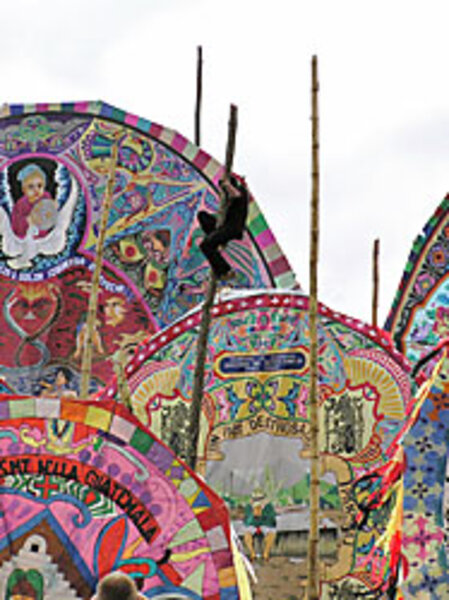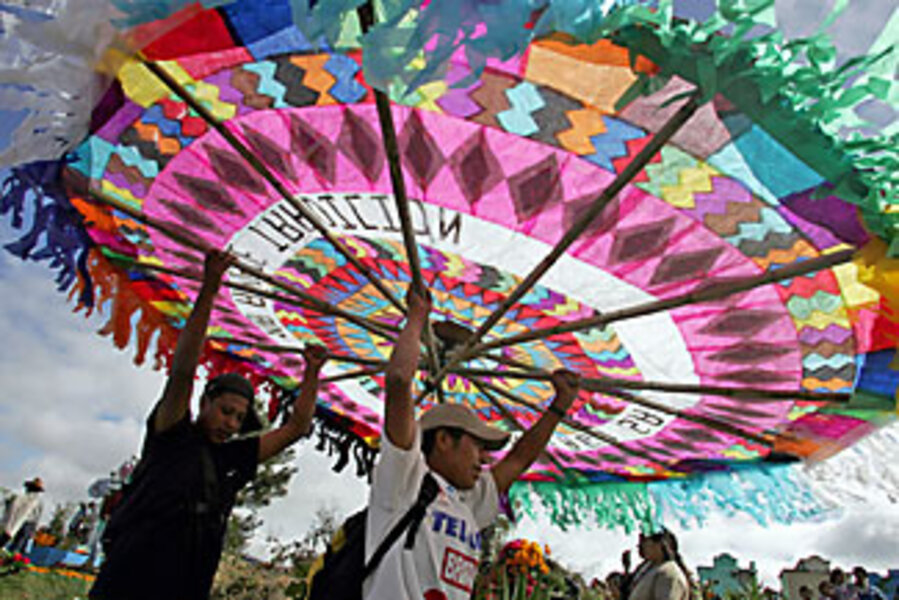Mayan pride flies high
Loading...
| Sumpango, Guatemala
In the highlands of Guatemala, even the smallest child seems to know how to string together a simple kite to ride the mountain breezes. Tugging on a fluttering piece of tissue until it becomes airborne – even for a few seconds – holds an endless fascination. But not just for children here. In Sumpango, it's the adults who have upped the ante on our relationship with the wind.
The Mayan village nestled in the lush hills about 15 miles north of Antigua is the site of Feria del Barrilete Gigante – a giant kite festival held each year on Nov. 1. These are kites the height of a house. The largest span 40 feet and are confections of lashed bamboo and vibrant tissue paper held together with gallons of glue. The smaller ones are made of corn stalks and twine.
When I was growing up, kites were always a staple of holidays. We would dash along the beach to lift them skyward and, occasionally in a moment of distraction, forget to hold on, only to see them float away. Here the relationship is more grounded. The Mayans have been launching their vibrant designs into the blustery winds for centuries. In this town and in Santiago Sacatepéquez a few miles away, that tradition has become an annual rite.
Legend has it the kites were flown on the Day of the Dead to honor ancestors and scare away evil spirits with the rustling of their paper tails. Now they seem to fly as much in quiet protest at the government. The intricate designs, which are months in the making, depict Mayan heritage and daily life and often express the suffering of the indigenous people or their social problems.
One kite declared in the middle of its vivid patterns: "Lágrimas de esperanza por una Guatemala en paz sin discriminación" (Tears of hope for a Guatemala in peace without discrimination). It was a sentiment echoed on other kites and seemed more than mere words in a country whose 36-year civil war came to an end only a decade ago.
I was visiting Guatemala to brush up my Spanish and had hopped on a bus to Sumpango, curious to see these giant kites. We were dropped off on a back road to avoid the crowds and clambered up a dirt bank onto the local soccer field, the highest point in town. By mid-morning, the kites were being assembled and hoisted up against poles in a display of huge vivid disks.
Only a gale-force wind could have whipped the largest ones up into the air, their guide ropes as thick as a forearm. Instead, they stood sentinel at the edge of the dusty field. The smaller ones had a chance at flight.
As the morning wore on, a team of boys and men tested the wind. They grasped a long rope attached to an 8-foot kite and ran into the gusting breeze. Spectators created a narrow corridor as the kite runners raced to pull their creation aloft before they ran into a wall – literally. With a final tug, the brightly colored disk rose steadily, then swooped down close to the heads of the crowd before sailing up again.
The fickle winds couldn't always hold the swerving kites, and they would come plunging down and scatter the crowds.
More teams pulled their kites into the air in the afternoon. Some were all-women teams in traditional dress. Others were made up of children or students. Ropes got tangled and shouts went up as a kite dive-bombed.
All the while, marimba music was being piped out of speakers at the other end of the field. And a traditional delicacy called fiambre – cold meat or fish marinated in vinaigrette – was served in makeshift restaurants.
As the day came to a close, a panel of judges awarded prizes based on size, color, design, and how high the kites flew.
For all the festivities, the giant kite festival was appealingly uncommercial and low key. Mayans are generally a shy people, and the kites seemed to convey their cultural pride and industry in a way no speeches or marching bands could capture – even though the festival had both.
High in the hills, the winds of conflict and change seemed to have left this town undisturbed in its kite observances.






